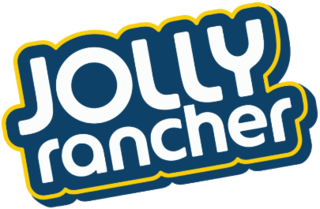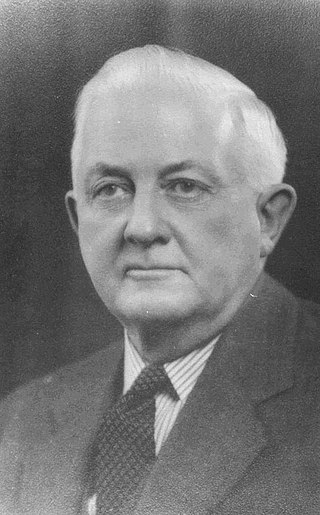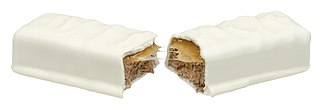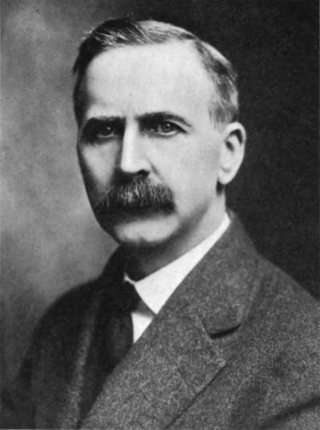
York Peppermint Pattie is an American dark chocolate enrobed peppermint confection introduced in 1940 and currently produced by the Hershey Company.

Bounty is a coconut-filled, chocolate-enrobed candy bar manufactured by Mars, Incorporated, introduced in 1951 in the United Kingdom and Canada. It is a direct emulation of the Mounds bar introduced by Peter Paul in 1936, and also copies the milk chocolate enrobing of Hershey's Almond Joy, introduced in 1948. It is no longer being sold in the United States.

Reese's Pieces are a peanut butter candy manufactured by The Hershey Company; they are oblate spheroid in shape and covered in candy shells that are colored yellow, orange, or brown. They can be purchased in plastic packets, cardboard boxes, or cup-shaped travel containers. The Reese company was founded by H.B. Reese. The H.B. Reese Candy Company was merged with The Hershey Company in 1963.

Jolly Rancher is an American brand of sweet hard candy, gummies, jelly beans, lollipops, sour bites, and a line of soda put out by Elizabeth Beverage Company in 2004. It is currently manufactured by The Hershey Company.

Almond Joy is a candy bar manufactured by Hershey's, consisting of sweetened, shredded coconut topped with whole almonds and covered in milk chocolate. The company also produces Mounds bars, a similar confection without nuts, coated in dark chocolate.

Reese's Take 5 is a candy bar that was released by The Hershey Company in December 2004. The original name of the candy bar was TAKE5 but common usage among consumers added a space. In June 2019, when the candy bar became part of the Reese's family, the name was officially changed to Reese's Take 5. The "5" in the name refers to the combination of five ingredients: chocolate, peanuts, caramel, peanut butter, and pretzels. This unique combination of ingredients earned Reese's Take 5 top honors in the 2019 LA Times official candy bar power rankings. The Take5 was known as Max 5 in Canada but has since been discontinued. Take5 has returned to Canada in the fall of 2020, under the name "Oh Henry Level Up".
The 5th Avenue is a candy bar introduced in 1936, consisting of peanut butter crunch layers enrobed in chocolate. It is produced and marketed by The Hershey Company.

Bon Appétit is a monthly American food and entertaining magazine, that typically contains recipes, entertaining ideas, restaurant recommendations, and wine reviews. Owned by Condé Nast, it is headquartered at the One World Trade Center in Manhattan, New York and has been in publication since 1956. Bon Appétit has been recognized for increasing its online presence in recent years through the use of social media, publishing recipes on their website, and maintaining a popular YouTube channel.

Mounds is a candy bar made by The Hershey Company, consisting of shredded, sweetened coconut coated in dark chocolate. The company also produces the Almond Joy, a similar bar topped by whole almonds and covered in milk chocolate. The two products share common packaging and logo design, with Mounds using a red color scheme and Almond Joy blue.

Harry Burnett Reese Sr was an American inventor and businessman known for creating the number one-selling candy brand in the United States Reese's Peanut Butter Cups and founding the H. B. Reese Candy Company. In 2009, he was posthumously inducted into the Candy Hall of Fame.

The Zero candy bar, introduced in 1920, is a candy bar composed of a combination of caramel, peanut and almond nougat covered with a layer of white chocolate fudge. Its outwardly white color — an unusual color for a candy bar — has become its trademark. The coating melted at a higher temperature than brown chocolates, making the bar a popular choice for summer vending in the pre-air conditioning South. Zero resembles Snickers, a candy manufactured by Mars, except Zero is white instead of dark brown.
The Clark Bar is a candy bar consisting of a crispy peanut butter/spun taffy core and coated in milk chocolate. It was introduced in 1917 by David L. Clark and was popular during and after both World Wars. It was the first American "combination" candy bar to achieve nationwide success. Two similar candy bars followed the Clark Bar, the Butterfinger bar (1923) made by the Curtiss Candy Company and the 5th Avenue bar (1936) created by Luden's.

Boyer Candy Company is an American candy company located in Altoona, Pennsylvania. The factory is located in the downtown district. Boyer Candy is privately owned by Consolidated Brands, which is owned by the Forgione family.

David Lytle Clark was an Irish entrepreneur who founded the D. L. Clark Company confectioners in 1886 in Allegheny, Pennsylvania, now part of Pittsburgh. He was born in County Londonderry, Ireland, the son of Samuel and Jane Clark. He had come to the U.S. with his family from Ireland when he was eight years old, and educated in the public schools. He began making candy in a one-room location in Allegheny City at the age of 19, and later expanded into making gum when learning in 1886 of a new approach using chicle. This he would use bright food coloring and flavor it with extracts of woodland leaves he had chewed as a boy. He is best known for his creation of the D. L. Clark Company, a confectionary, and for creating some of its best known products, including the Clark bar and the Zagnut, as well as for its spinoff, the Clark Chewing Gum Company with its Clark's Teaberry gum.

The D. L. Clark Company was founded in 1886 in Allegheny, Pennsylvania, now part of Pittsburgh, by David L. Clark (1864–1939), an Irish-born candy salesman. In 1921, Clark Brothers Chewing Gum Company was spun off as a separate corporation. In 1955, when the family-owned D. L. Clark company was sold to Beatrice Foods, they had production facilities in Pittsburgh and Evanston, Illinois. Beatrice sold it in 1983 to Leaf, and they in turn sold Clark in 1991, though Leaf retained the rights to Clark's Zagnut and P. C. Crunchers bars. The new owner, entrepreneur Michael P. Carlow, would operate it under the umbrella of the Pittsburgh Food & Beverage Company.

Coconut candy refer to various candies made with coconut or coconut flavorings.

Gummies, gummi candies, gummy candies, or jelly sweets are a broad category of gelatin-based chewable sweets. Gummy bears, Sour Patch Kids, and Jelly Babies are widely popular and are a well-known part of the sweets industry. Gummies are available in a wide variety of shapes, most commonly seen as colorful depictions of living things such as bears, babies, or worms. Various brands such as Bassett's, Haribo, Betty Crocker, Hersheys, Disney and Kellogg's manufacture various forms of gummy snacks, often targeted at young children. The name "gummi" originated in Germany, with the term "jelly sweets" more common in the British English language.
Susan Benjamin has researched communications and the cultural and political history of food for almost 40 years. She is founder of True Treats, the nation's only research-based candy and confection store, which was listed by Food Network magazine, delish.com and Holiday Lettings, Trip Advisor's international arm, as one of the nation's top 50 “Sweet Spots.” A former communications strategist and college professor, she participated in a White House initiative under Bill Clinton and George W. Bush, and has written nine books on related subjects, and published in legal journals, newspapers and online publications.















